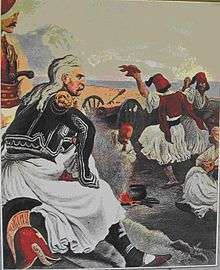Tsamiko
The Tsamikos (Greek: Τσάμικος, Tsamikos) or Kleftikos (Greek: Κλέφτικος) is a popular traditional folk dance of Greece, done to music of 3/4 meter.
The dance

The dance follows a strict and slow tempo not emphasising on the steps, but more on the "attitude, style and grace" of the dancer. The dancers hold each other from each other's hands, bent 90 degrees upwards at the elbows. It takes a sturdy hand, especially if you are supporting the first or last person of the line (or circle) who will lean on you to perform high acrobatic leaps (usually kicking his right leg up as he takes off followed by the left (in a scissor-like motion), hitting the latter with the back of his hand before landing). The steps are relatively easy but have to be precise and strictly on beat. The dancer might even stomp his foot in response to a strong beat. There is some improvisation involved and many variations of the steps, depending on which area the dancers come from. Over time the dance has taken on many variations. In the past, it was danced exclusively by men, but in modern times both men and women take part.
Tradition
The name Tsamiko literally means from Chameria or dance of the Chams.[1][2] Swiss musicologist Samuel Baud-Bovy noted that the Greek Tsamiko was not danced among Cham Albanians.[3] Its alternative name Kleftikos literally means dance of the Klephts, because it was associated with the klephts who fought during the Greek War of Independence (1821–1830).[4] Tsamiko is danced almost exclusively by men. Today Tsamiko is a popular dance in festivals and weddings, especially in the rural areas of Central Greece, Peloponnese, Thessaly as well as Epirus, where a slower version is performed.[5] Sometimes the dancers dress in the traditional Greek fustanella. This dance is usually performed to celebrate national events like in the anniversary of the declaration of the start of Greek War of Independence in 1821.
The Tsamiko of Central Greece (Roumeli) is regarded as the standard version of this dancing genre and is popular throughout Greece.[6] In Central Greece Tsamiko is the most popular folk dance.[7] The version of the Tsamiko danced in Central Greece (Roumeli) is accompanied by vocal and instrumental melodic lines and also the Peloponnese where it is known by the names Klephtikos horos (dance of the Klephts), Pidhiktos (leaping dance) or as the Arvanitikos horos (Arvanitic dance) and all terms are synonymous with Tsamiko.[8] In Peloponnese Tsamiko is one of the most popular folk genres together with Syrtos.[7]
In Epirus Tsamiko is especially popular in the regions of Ioannina and Thesprotia.[6] In general the Tsamiko of Epirus retains a slower tempo compared to the Tsamiko of Central Greece.[9] The Epirote dances Kleftes and Perdikomata have been sometimes regarded as variants of Tsamiko,[10] although this isn't universally accepted since they have been also classified as distinct genres.[11] A general classification of the dancing genres in Zagori region of Epirus can classify Osmanatakas and Berati as variations of Tsamiko too.[12]
Although one of the main dancing genres in Epirus, Tsamiko is not the most popular folk genre in local discography.[13]
The definition of "true" Tsamiko is obscure due to the many regional, choreographic, musical variations, versions and names of the dance.[8]
References
- Lenis, 2009, p. 20: "Ο τσάμικος Ηπείρου ...τον σημερινό Καλαμά)."
- Sugarman, Jane (2003). Magrini, Tullia (ed.). Music and gender: Perspectives from the Mediterranean. University of Chicago Press. pp. 89–90. ISBN 9780226501666.CS1 maint: ref=harv (link)
- Samuel Baud-Bovy, Phoibos Anōgeianakēs (1984). Δοκίμιο για το Ελληνικό Δημοτικό Τραγούδι [Volume for Greek Folksongs]. Peloponnēsiako Laographiko Hidryma. p. 34.
Τον ελληνικό Τσάμικο δε φαίνεται να τον χορεύουν οι Αρβανίτες Τσάμηδες, ενώ έχουν χορούς σε 5/4
- Mouzaki, Rozanna (1981). Greek dances for Americans. Doubleday. p. 55.
It is also called Kleftikos because it was danced by the fighters and rebels (Klefts) of the Greek Revolution of 1821 against the Turks.
- Hellander Paul, Armstrong Kate. Greece. Lonely Planet, 2006 ISBN 978-1-74059-750-0, p. 67.
- Lenis, 2009, p. 24
- Romaios, Kostas (1980). Κοντὰ στὶς ρίζες: ἔρευνα στὸν ψυχικὸ κόσμο του Ελληνικου λαου (in Greek). Βιβλιοπωλειον της Εστιας Ι.Δ. Κολλαρου. p. 306.
Στη Ρουμελη κυριαρχεί π.χ. ό τσάμικος, στα νησιά οί συρτοί. Στο Μοριά συνυπάρχουν, σέ αρμονική ποσοτική αναλογία, καΐ ό τσάμικος και οί συρτοί.
- Koço, Eno (2015). A Journey of the Vocal Iso(n). Newcastle upon Tyne: Cambridge Scholars Publishing. ISBN 978-1-4438-7578-3.CS1 maint: ref=harv (link) p. 14. "In a review on Doris and Erich Stockmann’s ... its counterpart in northern Greece (Chianis 1967, 16)."
- Lenis, 2009, p. 23
- Lenis, 2009, p. 34
- Bellos, Giannis. Μουσική και χορός – Αναφορά στους ρυθμούς της Ηπείρου. Κόνιτσα Ιωαννίνων. Work published in the 18th World Meeting in Dancing Research. Retrieved 22 February 2017.
- Sokratis, Pappas (1 January 2013). Ο ρόλος του λαούτου στις λαϊκές εθιμικές εκδηλώσεις στα Ζαγοροχώρια του νομού Ιωαννίνων. ΤΕΙ of Ionian Islands (in Greek). p. 20. Retrieved 22 February 2017.
- Lenis, 2009, p. 46
Sources
- Ilias, Lenis (2009). Η Ρυθμική Συγκρότηση της Μουσικής της Ηπείρου. Technological Educational Institute of Epirus. Retrieved 22 February 2017.
- M. and R. Schiel, Volkstänze aus Griechenland. Romiosini 1995.